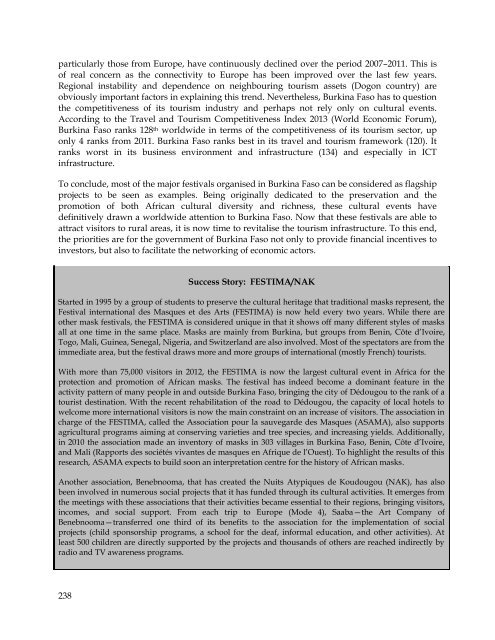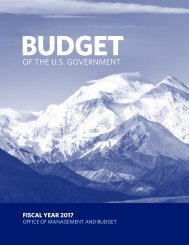CASE STUDIES FROM AFRICA
30769-doc-services_exports_for_growth_and_development_africa
30769-doc-services_exports_for_growth_and_development_africa
You also want an ePaper? Increase the reach of your titles
YUMPU automatically turns print PDFs into web optimized ePapers that Google loves.
particularly those from Europe, have continuously declined over the period 2007–2011. This is<br />
of real concern as the connectivity to Europe has been improved over the last few years.<br />
Regional instability and dependence on neighbouring tourism assets (Dogon country) are<br />
obviously important factors in explaining this trend. Nevertheless, Burkina Faso has to question<br />
the competitiveness of its tourism industry and perhaps not rely only on cultural events.<br />
According to the Travel and Tourism Competitiveness Index 2013 (World Economic Forum),<br />
Burkina Faso ranks 128 th worldwide in terms of the competitiveness of its tourism sector, up<br />
only 4 ranks from 2011. Burkina Faso ranks best in its travel and tourism framework (120). It<br />
ranks worst in its business environment and infrastructure (134) and especially in ICT<br />
infrastructure.<br />
To conclude, most of the major festivals organised in Burkina Faso can be considered as flagship<br />
projects to be seen as examples. Being originally dedicated to the preservation and the<br />
promotion of both African cultural diversity and richness, these cultural events have<br />
definitively drawn a worldwide attention to Burkina Faso. Now that these festivals are able to<br />
attract visitors to rural areas, it is now time to revitalise the tourism infrastructure. To this end,<br />
the priorities are for the government of Burkina Faso not only to provide financial incentives to<br />
investors, but also to facilitate the networking of economic actors.<br />
Success Story: FESTIMA/NAK<br />
Started in 1995 by a group of students to preserve the cultural heritage that traditional masks represent, the<br />
Festival international des Masques et des Arts (FESTIMA) is now held every two years. While there are<br />
other mask festivals, the FESTIMA is considered unique in that it shows off many different styles of masks<br />
all at one time in the same place. Masks are mainly from Burkina, but groups from Benin, Côte d’Ivoire,<br />
Togo, Mali, Guinea, Senegal, Nigeria, and Switzerland are also involved. Most of the spectators are from the<br />
immediate area, but the festival draws more and more groups of international (mostly French) tourists.<br />
With more than 75,000 visitors in 2012, the FESTIMA is now the largest cultural event in Africa for the<br />
protection and promotion of African masks. The festival has indeed become a dominant feature in the<br />
activity pattern of many people in and outside Burkina Faso, bringing the city of Dédougou to the rank of a<br />
tourist destination. With the recent rehabilitation of the road to Dédougou, the capacity of local hotels to<br />
welcome more international visitors is now the main constraint on an increase of visitors. The association in<br />
charge of the FESTIMA, called the Association pour la sauvegarde des Masques (ASAMA), also supports<br />
agricultural programs aiming at conserving varieties and tree species, and increasing yields. Additionally,<br />
in 2010 the association made an inventory of masks in 303 villages in Burkina Faso, Benin, Côte d’Ivoire,<br />
and Mali (Rapports des sociétés vivantes de masques en Afrique de l’Ouest). To highlight the results of this<br />
research, ASAMA expects to build soon an interpretation centre for the history of African masks.<br />
Another association, Benebnooma, that has created the Nuits Atypiques de Koudougou (NAK), has also<br />
been involved in numerous social projects that it has funded through its cultural activities. It emerges from<br />
the meetings with these associations that their activities became essential to their regions, bringing visitors,<br />
incomes, and social support. From each trip to Europe (Mode 4), Saaba—the Art Company of<br />
Benebnooma—transferred one third of its benefits to the association for the implementation of social<br />
projects (child sponsorship programs, a school for the deaf, informal education, and other activities). At<br />
least 500 children are directly supported by the projects and thousands of others are reached indirectly by<br />
radio and TV awareness programs.<br />
238




